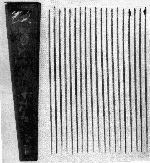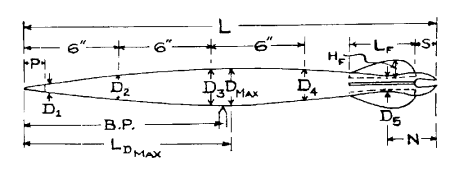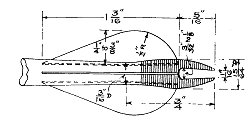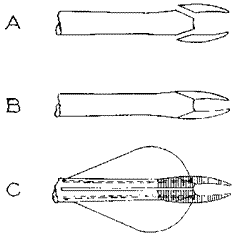TURKISH FLIGHT ARROWS
By Fred Isles
The National Company of Crossbowmen of the U.S.A.
This article was first published in the Journal of the Society of Archer-Antiquaries, volume 4, 1961.
Please read the copyright notice!
As all devotees of flight shooting are aware, the distance records established by the Turks centuries ago remain unsurpassed. This, in spite of recent advances in the technology of bow construction.
The maximum flight record set by Turkish archers, shooting in the conventional manner, seems to have been at least 874 yards, and may have exceeded 950 yards. The greatest distance thus far attained by modern flight archers, likewise shooting conventionally, is about 850 yards. Our "free-style" flight record, made in 1959 with a foot-bow, is 937.13 yards.
Several writers -- notably Dr. Paul E. Klopsteg, in his Turkish Archery and the Composite Bow, and, in lesser detail, Sir Ralph Payne-Gallwey in his Treatise on Turkish and Other Oriental Bows of Medieval and Later Times -- have supplied much information on the construction and performance of Turkish bows and arrows. Seeking to amplify these data, and, more objectively, to enable himself to try to design crossbow flight arrows embodying such of the salient features of Turkish flight arrows as might be pertinent, the writer, with the kind co-operation of Mr. Stephen V. Granscay, Curator of Arms and Armor, and his staff, has examined and measured out fifty such ancient arrows in the Metropolitan Museum of Art, New York City.

Fig. 1. Turkish Flight Arrows
Courtesy of the Metropolitan Museum of Art
Two groups of flight arrows were studied, one composed of eighteen arrows known to be Turkish and very old, but otherwise unidentified (see Fig. 1); the other comprising thirty-seven arrows from the Stone Collection, dating perhaps from the 1700's. The latter group are those illustrated in Dr. Klopsteg's book, and in Fig. 2. All the arrows examined were barrelled -- that is, tapering from the approximate middle toward both ends; were very straight, markedly resilient, and seemed to be made of a conifer wood.

Fig. 2. Turkish Quiver and Flight Arrows
Courtesy of the Metropolitan Museum of Art
The measurements taken are given in Fig. 3. They include overall length, diameter at tip, quarter-length, middle, three-quarter-length and constricted section just before the bulbous nock; maximum diameter and its location; weight in grains; stiffness, as indicated by the deflection produced by a two-pound weight hung from the mid-point of the arrow when the latter rests on two supports 22 inches apart; size of pile; distance of balance-point from tip of pile; number, size and location of feathers, and dimensions of the nock. Since there appeared to be little to gain by presenting the individual measurements of each arrow, in view of the comparative uniformity among them, only the maximum average and minimum values of the measurements mentioned are presented in Fig. 3. The figures for "stiffness" are the averages of the deflections resulting from the pull of the two-pound weight applied first with the grain of the arrow running vertically, then horizontally; there was very little difference, however the arrow might be rotated on the supports.
 Fig. 3.
Fig. 3.
In this writer's opinion, there is no reason for believing that all Turkish flight arrows conformed rigidly to the dimensions of those examined. This seems to be substantiated by the statement of Kani, the Turkish archer-author whose book, published in 1847, has provided Dr. Klopsteg with much of his source material, to the effect that "the length of the arrow depends primarily on the stature of the archer and the characteristics of his bow".

One need refer no further than to the celebrated flight shooting of Mahmoud Effendi, Secretary to the Turkish Ambassador in London, in 1794, when a guest of the Royal Toxophilite Society. According to the eye-witness account quoted by Dr. Klopsteg, Mahmoud used a 25 -- inch arrow; those studied in the Museum varied little from 24- inches in length.
Similarly, Payne-Gallwey has this to say about Turkish flight arrows: --
"Length: 25 1/2 to 25 3/4 inches.
Weight: 7 drs. avoirdupois (191 grains).
Balance Point: 12 inches from end of nock.
Shape: Barrelled, and much tapered from balancing-point to its ends; its sharp ivory point being only 1/8 inch in diameter (where it is fitted to the shaft) and 1/4 inch in length. The part of the shaft to which the feathers are attached is 3/16 inch in diameter, and the centre of the shaft, 5/16 inch.
"Though I have carefully measured and weighed about two hundred eighteenth-century Turkish flight arrows, I have scarce found a half-a-dozen that were 1/8 inch more or less than from 25 1/2 to 25 3/4 inches in length, or that varied by even as little as 1/2 dr. (13.7 grains)from 7 dr. (191 grains) in weight. In regard to their balancing-point, these arrows are equally exact, as this part is invariably from 11 1/2 to 12 1/2 inches from the nock.
"It is evident that the old Turkish flight arrow was made to a standard pattern that experience showed was the best for long distance shooting.
"The light and elegantly shaped wooden nock of an old Turkish arrow is quite unlike the clumsy horn nock of the modern (about 1907) European one. The latter cannot withstand the recoil of the Turkish bow and soon splits apart, though in the thousands of times I have discharged Turkish arrows I have never known one to split at the nock.
|

Fig. 5.
|
A: Butt end of arrow, with projecting wooden halves of nock shaped and ready to be glued to shaft.
|
|
B: Halves of nock glued to shaft.
|
|
C: Wrapping of fine sinew, soaked in hot glue, wound about nock; cut away across notch.
Three feathers, 120 degrees apart, glued to shaft, with little or no spiraling. One in line with notch.
|
"It will be noticed (Fig. 5) that the shape of the Turkish nock -- with its narrow entrance that springs apart to admit the bow-string and then closes again -- enables an archer, even on horseback, to carry an arrow ready for use on the string of his bow.
"The feathers (3) of a Turkish flight arrow, though stiff, are thin as paper, and are 2 1/2 inches long and 1/4 inch high near the nock. They were often made of parchment. (A footnote states that parchment feathering increases the range of a flight arrow by at least thirty yards.)
"The dark band of shading to be seen round the nock in Fig. 5c is a wrapping of fine thread-like sinew. This sinew, after being soaked in hot glue, was wound to a thickness of about 1/32 inch all over the nock, and it thus held the halves of the latter securely to the shaft.
"When dry, the wrapping of sinew was cut out where it crossed the opening for the bow-string. It nevertheless gave a great increase of strength to the thin projecting halves of the nock, as it covered them on their outer surfaces with a sheathing that was very tough and elastic, and as smooth as glass to the touch. The wrapping was, of course, applied before the feathers were glued on.
"So careful were the Turks in the construction of their arrows, that even the halves of their nocks were made from wood with a natural curve to suit the finished outline. It is possible, of course, they would not otherwise have withstood the violent shock of the released bowstring.
"It may be said that every inch in length of a Turkish bow or arrow was named in a manner that could be recognised or referred to. In a general way the parts of an arrow were known as follows: The enlarged centre, the 'stomach', from centre to point, the 'trowser', from centre to nock, the 'neck'."
Sir Ralph's statements and descriptions are essentially corroborated by Mustafa Kani, as reported by Dr. Klopsteg; who adds that "pine, alone, was used for arrows in Kani's time", and that "the flight arrow called 'pishrev' was the most important from our point of view. It was a self-arrow of pine, with a bone tip. Its nock was of brazil wood, but occasionally wild goat's horn was substituted. The average length is reported to have been 24 1/2 inches. The length of the feather was 1 1/4 inches and its greatest height 13/32 inch. The pishrev arrow alone was used in tournament competition." And further, that "in some cases lead was inserted in a hole drilled in the bottom of the nock to bring the balance point near or behind the middle. Experience shows such arrows to fly farther".
| |
Lot 35.113 - 2 -
(18 Flight Arrows)
|
LOT 36.25.2562 -
(11 Flight Arrows)
representative of 37
in Lot)
|
| |
|
|
|
|
|
|
|
| |
Max. 24.69
|
Avg. 24.56
|
Min. 24.31
|
|
Max. 24.84
|
Avg. 24.61 .
|
Min. 24.41
|
| Overall Length |
|
|
|
|
|
|
|
| Diameters |
|
|
|
|
|
|
|
| Base of Pile ... ... ... ... (D1) |
.13
|
.11
|
.08
|
|
.13
|
.11
|
.09
|
| At 6 in. from Point ... ... (D2) |
.25
|
.22
|
.20
|
|
|
|
|
| At 12 in. from Point ... ... (D3) |
.30
|
.27
|
.25
|
|
.28
|
.26
|
.25
|
| At 18 in. from Point ... ... (D4) |
.28
|
.26
|
.23
|
|
|
|
|
| Constriction before Nock ... (D5) |
.20
|
.19
|
.17
|
|
.22
|
.19
|
.19
|
| Maximum Diameter ... ... ... (D Max.) |
.30
|
.27
|
.25
|
|
.28
|
.27
|
.27
|
| Distance of Maximum Diameter |
|
|
|
|
|
|
|
| from Point ... ... ... (L D Max.) |
13.88
|
13.43
|
13.13
|
|
14.00
|
13.60
|
13.19
|
| Distance of Balance Point |
|
|
|
|
|
|
|
| from point ... ... ... (B.P.) |
13.88
|
13.43
|
13.13
|
|
14.00
|
13.60
|
13.19
|
| Length of Pile ... ... ... (P) |
.34
|
.27
|
.25
|
|
|
|
|
| Length of Nock ... ... ... (N) |
.75
|
.72
|
.59
|
|
|
.69
|
|
| Length of Notch ... ... ... (S) |
.31
|
.30
|
.25
|
|
|
.31
|
|
| Length of Feathers* ... ... (LF) |
1.94
|
1.34
|
1.13
|
|
|
1.19
|
|
| Height of Feathers ......... (HF) |
.38
|
.31
|
.25
|
|
|
.31
|
|
| Weight of Arrow ... ... ... grains |
236
|
196
|
162
|
|
195
|
187
|
167
|
| Deflection produced by a 2 |
|
|
|
|
|
|
|
| lb. weight at Middle, with |
|
|
|
|
|
|
|
| Arrow resting on Two |
|
|
|
|
|
|
|
| Supports 22 ins. apart** inches |
.81
|
.58
|
.33
|
|
|
|
|
* Three feathers, 120 degrees apart, with little or no spiraling; one in line with notch.
** Averages of the deflections resulting from the pull of the 2 lb. weight applied first with the grain of the arrow running vertically, then horizontally. There was very little difference, however the arrow might be rotated on the supports.
Source: http://margo.student.utwente.nl/sagi/artikel/turkish/








